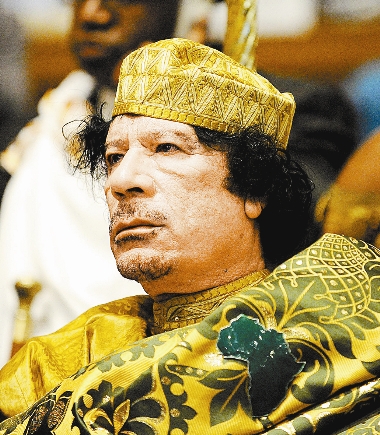 The popular uprising against Moammar Gadhafi escalated this week, leaving Libya’s leader of 41 years increasingly isolated and in danger of encirclement as he fights for survival. THE scope of Moammar Gadhafi’s control was whittled away Wednesday as major Libyan cities and towns closer to the capital Tripoli fell to the rebellion against his rule. At least 300 protesters are believed to have been killed by pro-government forces in the past week of clashes. In the east, now all but broken away, the opposition vowed to “liberate” Tripoli, where the Libyan leader is holed up with a force of militiamen roaming the streets and tanks guarding the outskirts. The extent of Gadhafi’s control over the country he has ruled for 41 years had been reduced to the western coastal region around Tripoli, the deserts to the south and parts of the center. Gadhafi long kept his army weak and divided for fear of challenge, so in the fierce crackdown his regime has waged on the uprising, he has relied on militia groups, beefed up by mercenaries hired abroad. Meanwhile, army units in many places have sided with the rebellion. Gadhafi led the revolution that set up the Libyan republic in 1969. His dream was to unite all Arab lands and create a system of “government by the masses.” However, by encouraging and helping provide funds for terrorist activities against Israel and its allies, he became an enemy of many countries. Gadhafi was born in 1942 in the desert region of Libya. His parents barely made a living herding sheep and goats. He was the last child and only son. Gadhafi was an intelligent boy, and his family made many sacrifices so he could receive an education. While in school he became inspired by the ideas of Gamal Abdel Nasser (1918-1970), one of the strongest voices calling for Arab independence and unity and a man who had helped overthrow King Farouk (1920-1965) of Egypt in 1952. Gadhafi began to organize student protests against Israel, which had been at war with several Arab nations after gaining its independence in 1948. He was expelled as a result and moved to the city of Misurata, Libya, where he completed his high-school education between 1961 and 1963. At the same time he began to organize a movement to overthrow King Idris (1890-1983), who had become Libya’s first head of state when the country won its independence from Italy in 1951. Gadhafi felt that King Idris allowed Western powers such as Britain and the United States to have too much say in Libyan affairs. After joining the army in October 1963, Gadhafi found more supporters to help his cause. On Sept. 1, 1969, when King Idris was out of the country for health reasons, Gadhafi put his plan into effect. He and his young officers easily took over government and military offices and proclaimed Libya an Arab republic. Gadhafi became president of the Revolutionary Command Council (RCC) and had total control over the new republic. Following the example of his hero, Nasser, Gadhafi called for the removal of American and British military bases from Libya. This action was completed in June 1970. There were many attempts, by both Libyans and the agents of foreign governments, to overthrow or kill Gadhafi in the early 1980s. He survived and remained the unquestioned leader of the republic. As acts of international terrorism became more frequent in the 1980s, Gadhafi drew increased attention as the alleged source of training and funding for such activities. On Dec. 27, 1985, Palestinian terrorists attacked airports in Rome, Italy, and Vienna, Austria. U.S. president Ronald Reagan accused Libya of being behind the attacks, but Gadhafi denied involvement. On Jan. 1, 1986, Reagan ordered all U.S. citizens to leave Libya, and on April 14 the United States bombed the country. Nearly 100 people were killed in the attack. Gadhafi was injured, and his infant daughter was killed. After two Libyan men were accused of blowing up a Pan American jet over Lockerbie, Scotland, in 1988, killing 270 people, Gadhafi was ordered to turn over the suspects for trial. His refusal led the United Nations to impose sanctions against Libya. These sanctions were lifted in 1999 when the two men were finally brought to trial for the bombing. A court in France ruled in 2000 that Gadhafi could be brought to trial in France for his role in another bombing in 1989. In that incident, 171 people were killed when a bomb exploded in a French airplane over the African country of Niger. Gadhafi continued to deny that he was a supporter of terrorism and refused demands that he make payments to families of victims. Although U.S. sanctions against Libya remained in place, the removal of those imposed by the United Nations led to new efforts by Gadhafi to improve relations with other African and European countries. At a July 2001 meeting of the Organization of African Unity, African leaders agreed to reorganize the group, to change its name to the African Union, and to work toward greater unity among all member nations. Gadhafi was the leader in the creation of this plan and spent US$1 million to support it. (SD-Agencies) | 
